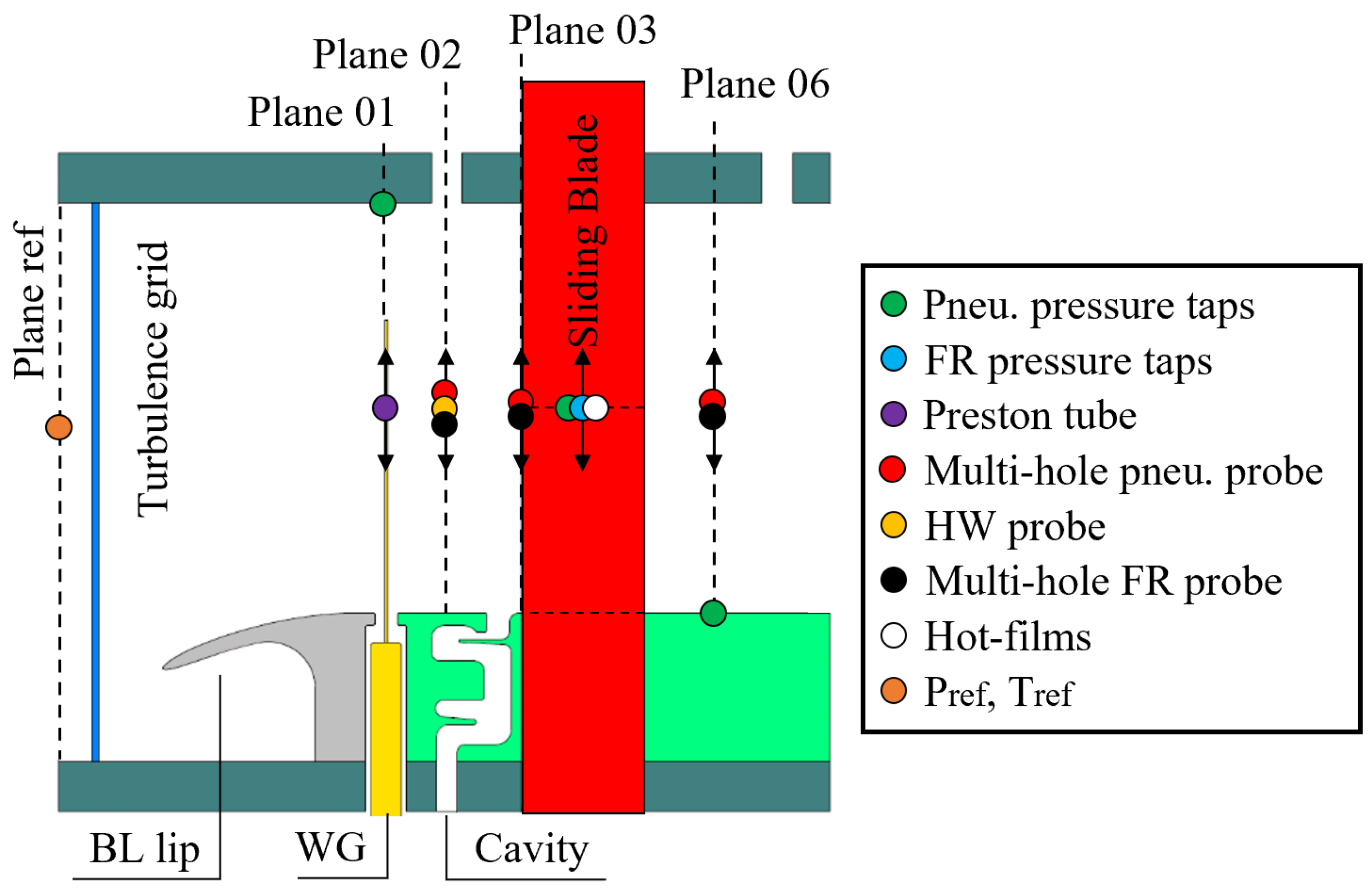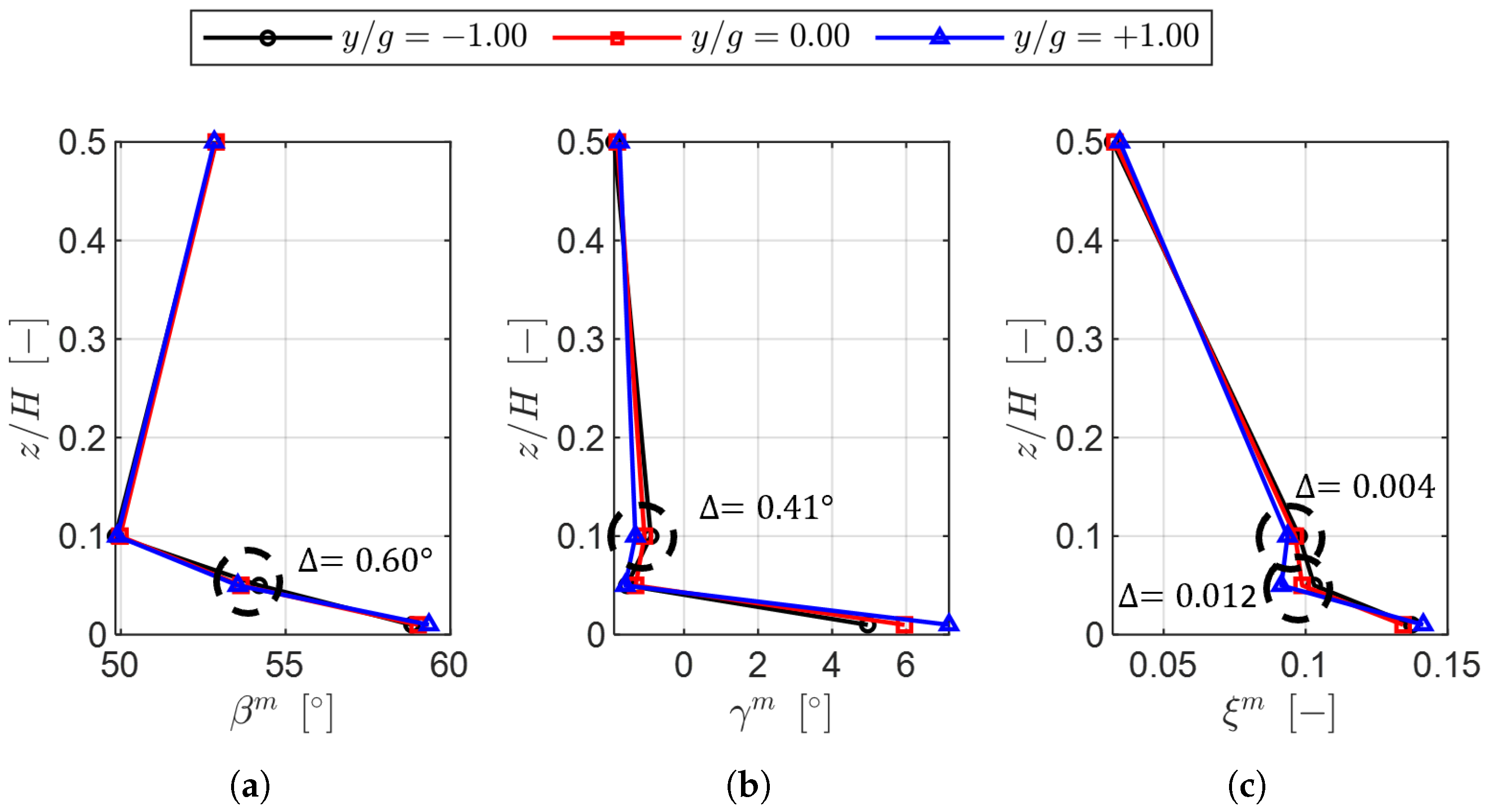1. Introduction
Aviation accounts for 3% of global
emissions, and 4% in Europe [
1,
2], with the Flightpath2050 initiative targeting net-zero emissions by 2050. This requires reducing
, NOx, and noise by 75%, 90%, and 65%, respectively, compared to 2000 levels. Despite efficiency improvements that have cut
emissions by over 50% since 1990 [
3], growth in air traffic risks offsetting these gains, with emissions projected to hit 2000 Mt by 2050 without further action. Gas turbines remain essential for cutting emissions, particularly on short- and medium-haul flights, which are forecast to account for 55% of
emissions while representing over 90% of flights by 2050 (
https://www.clean-aviation.eu/media/publications/technology-evaluator-first-global-assessment-2020-technical-report, accessed on 6 January 2025).
Increasing turbofan propulsive efficiency, particularly through higher bypass ratios (BPR), is a key approach to lowering specific fuel consumption (SFC) [
4]. However, further increases in BPR are limited by fan size, nacelle drag, and challenges around integration with the airframe [
5,
6,
7]. Geared turbofan (GTF) architectures address these issues by decoupling the fan and low-pressure turbine (LPT) speeds, enabling larger fans and higher bypass ratio without compromising performance [
4].
Geared turbofans (GTFs) achieve significant reductions in specific fuel consumption (SFC), especially at bypass ratios (BPR) above 10. The low-pressure turbine in GTFs operates at higher peripheral speeds, allowing lower stage loading and flow coefficients, which leads to fewer stages and improved efficiency [
8]. However, these conditions pose aerodynamic and structural challenges such as compressibility effects on losses and boundary layer behavior [
9]. At the aerodynamic level, the turbine operates at transonic Mach numbers exceeding 0.80 at the outlet. The faster spool speed introduces greater mechanical loads, necessitating design adaptations [
10,
11]. Torre et al. [
12] demonstrated the changes in operating points in a full-scale intermediate-pressure turbine for geared applications compared to direct-drive turbofans.
Traditionally, research efforts aimed at optimizing the performance of (ultra-) high-lift blade designs [
13] have led to extensive characterization of these profiles under both steady and unsteady conditions in fully subsonic low-pressure turbine rigs (
< 0.7). The findings of these studies have been well documented in works such as [
14,
15,
16]. However, as the current focus of industry lies on transonic turbine blades, our understanding of compressible flows over high-speed profiles remains incomplete.
Modern high-speed low-pressure turbine designs require investigating the effect of high Mach numbers and low Reynolds numbers on the interactions of unsteady wakes, secondary, leakage, and purge flows, as well as on the underlying loss mechanisms of high-speed low-pressure turbines [
17]. Moreover, at transonic exit Mach numbers, shock–boundary layer interactions occur on the suction-side boundary layer [
18].
Malzacher et al. [
11] demonstrated the performance enhancement of high-speed low-pressure turbines through two-stage turbine testing at engine-relevant Mach and Reynolds numbers and temperatures. Two blade profiles were tested in a linear cascade at Reynolds numbers of 60,000 and 77,000 with Mach numbers exceeding 0.80. Vera et al. [
19,
20] conducted linear cascade tests on high-speed turbine profiles at Reynolds numbers starting from 130,000 and Mach numbers between 0.61 and 0.83, examining both steady and unsteady inlet flows. The unsteady wakes were characterized by a bar reduced frequency of 0.47 and 0.35 as the Mach number increased. Steady annular cascade and rotating turbine rig studies by [
17] and [
21] investigated Mach numbers from 0.50 to 0.90 and Reynolds numbers from 120,000 to 315,000, focusing on the combined effects of unsteady wakes, surface finish, and aerodynamic performance. Boerner and Niehuis [
18] analyzed shock–boundary layer interactions in a high-speed linear cascade at Mach ∼0.95 and Reynolds numbers between 100,000 and 200,000, emphasizing shock strength and boundary layer state influences on blade loading and total pressure losses.
Despite these contributions, key aspects remain underexplored. Considering their critical influence on shock–boundary layer interaction and boundary layer transition, further studies are needed on short- to mid-range low-pressure turbines operating at Reynolds numbers between 50,000 and 150,000 [
17]. The aerodynamics of low- to mid-lift profiles at transonic Mach numbers (0.90–0.95) also require further investigation [
18]. Additionally, experimental data for validating secondary flow models under low Reynolds regimes remain scarce but crucial [
22,
23]. Real engine flow behavior is strongly influenced by off-design conditions due to shaft speed variations, and also lacks comprehensive experimental data on Reynolds and Mach number effects in high-speed low-pressure turbine conditions [
24].
This work introduces the SPLEEN C1, a novel open-access test case for high-speed low-pressure turbines designed to address the gap in high-quality experimental data at engine-relevant conditions. While secondary flows in linear cascades do not fully represent engine environments, they are widely used for secondary flow studies and model correlations [
22,
23,
25,
26]. Therefore, linear cascade measurements were chosen to explore secondary flow interactions with turbine blades and to assess the effects of Reynolds and Mach numbers on loss mechanisms and secondary flow characteristics, with high accuracy in boundary condition definition. The experimental rig enables systematic variations in Reynolds numbers between 50,000 and 150,000 and transonic exit Mach numbers from 0.60 to 0.95, while replicating unsteady wake effects and secondary flow features observed in real engine conditions. This setup provides high-fidelity data to improve computational models, focusing on flow phenomena relevant to next-generation geared turbofan engines.
The dataset includes comprehensive measurements of a low-lift profile representative of the hub section of a modern low-pressure turbine blade characterized by a thin laminar open separation bubble. Tests were conducted at Mach numbers between 0.70–0.95 and Reynolds numbers from 65,000–120,000, capturing both 2D blade aerodynamics and endwall flows. These conditions enable a detailed investigation of the effects of Reynolds and Mach numbers under challenging off-design operating conditions, offering valuable data for validating loss models, developing transition models for Reynolds-averaged Navier–Stokes simulations, and validating high-order direct numerical simulations.
This paper describes the test case and experimental methodology, detailing the design of the blade profile and the adaptation of the linear cascade for high-speed 3D aerodynamic testing. Results from the rig commissioning are presented, including flow condition stability, inlet boundary layer characteristics, free stream turbulence intensity, and length scales. The periodicity of the flow field in the cascade is also investigated. The current work updates and expands upon the initial findings published in [
27].
3. Test Section
The test section was significantly redesigned to enhance its ability to test quasi-3D flows in a linear cascade setup. This redesign allowed for the characterization of profile aerodynamics and secondary flows in low-pressure turbine blades operating at engine-relevant Mach and Reynolds numbers while considering the combined effects of unsteady wakes and purge flows. The project introduced the concept of a sliding instrumented blade (see
Section 4.2.3) to traverse the sensor location from midspan to the endwall.
The adaptation involved translating one of the endwalls to accommodate the cavity geometry. This modification required the addition of a passive boundary layer control feature consisting of a splitter plate with a downward twisted leading edge. A super-elliptical leading edge [
39] was employed to prevent separation and reduce sensitivity to incidence angles. The distance between the lip leading edge and the cascade leading edge was kept constant in order to maintain uniform boundary layer development across the pitchwise direction. The boundary layer lip is highlighted in
Figure 4.
A passive turbulence grid was used to increase the turbulence level in the test section. This grid consists of an array of parallel cylindrical bars with a diameter of 2 mm and a mesh size of 12 mm. The correlation of Roach [
40] was applied to determine the axial distance between the central blade and the turbulence grid. Positioned 400 mm upstream of the cascade central blade leading edge, the grid produced a turbulence level of approximately 2.4%. Hot-wire experiments were conducted to validate the correlation and assess turbulence decay upstream of the cascade (see
Section 5.1). The position of the turbulence grid relative to the cascade is highlighted in
Figure 4.
Tests concerning unsteady effects used a spoked wheel-type wake generator (WG) featuring 96 cylindrical bars with a diameter of 1.00 mm. The wake generator bars sit 1.12 axial chords upstream of the cascade leading edge plane. As suggested by Pfeil et al. [
41], the bar diameter was selected to be similar to the blade trailing edge thickness in order to ensure a far wake similar that shed by an airfoil. The bars extended to ∼73% of the cascade span when parallel to the leading edge of the central blade.
Figure 5a schematically represents the test section constituents: the turbulence grid (TG), high-speed wake generator (WG), boundary layer (BL) lip, cavity geometry, and sliding blade. The assembled components within the VKI S-1/C are displayed in
Figure 5b.
6. Conclusions
This work presents the SPLEEN C1 test case, which is designed to provide high-quality data on aerodynamics and loss generation in high-speed low-pressure turbine blades at low Reynolds numbers along with the interactions between cavity flows, secondary flows, and wakes under engine-like conditions. The test case was investigated within the EU-funded SPLEEN project and conducted in a transonic low-Reynolds linear cascade. This paper details the geometry, experimental setup, and instrumentation.
Inlet turbulence was characterized using a hot-wire measurement technique for transonic rarefied flows. The results concerning turbulence decay after the passive grid agree with established turbulence decay correlations in the literature.
The facility was commissioned to assess inlet flow characteristics, stability, and periodicity. Stability was confirmed, with the standard deviation, with 95% confidence interval, of the Mach and Reynolds numbers being within ±0.92% and ±0.82% from the nominal values, respectively. The Strouhal number was within ±0.54% and the purge massflow ratio within ±0.003%.
The periodicity of the inlet boundary layer at Plane 01 was characterized by low variability, with displacement thickness variations within ±0.35% of the chord and total pressure deviations below 0.10%. However, nonuniformities emerged downstream at Plane 02 due to the wake generator, in particular near the endwall, where the incidence varied by up to ±2.00 and the total pressure by ±1.25%. These variations were linked to boundary layer thickness growth and skewness, which contributed to localized flow nonperiodicity.
At the cascade outlet, the wake generator amplified pitch-to-pitch variations in the kinetic energy loss coefficient, with maximum deviations reaching ±0.5% in the secondary flow region. The increased inlet boundary layer thickness and negative skewness toward negative pitchwise locations correlated with higher secondary losses, as predicted by the Coull and Clark model [
23], resulting in a secondary loss increase of approximately 0.014. The introduction of purge flow significantly mitigated these periodicity variations, particularly near the endwall, which was due to stabilizing of the secondary flow structures and reducing the displacement of the loss cores.
This work constitutes the baseline for a thorough investigation of the impact of unsteady wakes on the combined interaction of secondary flows and purge flows in high-speed low-pressure turbine geometries operating at engine-relevant conditions.

































